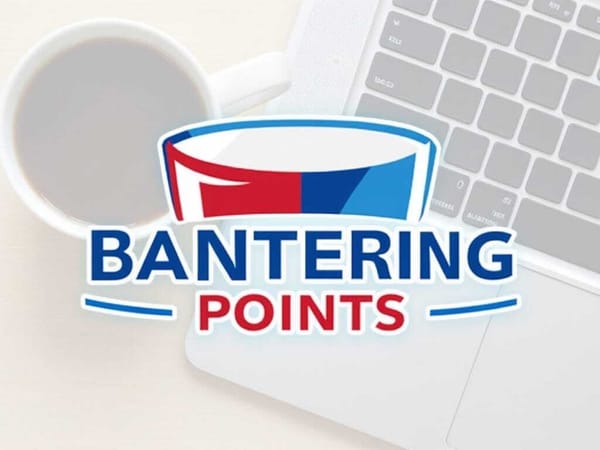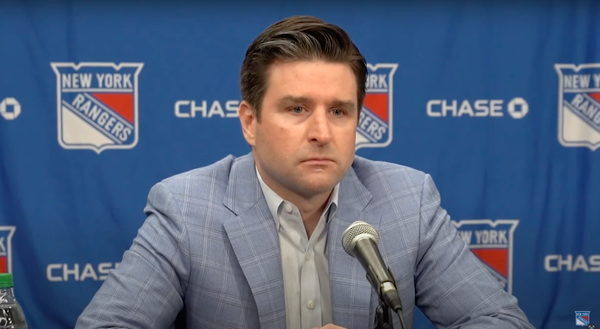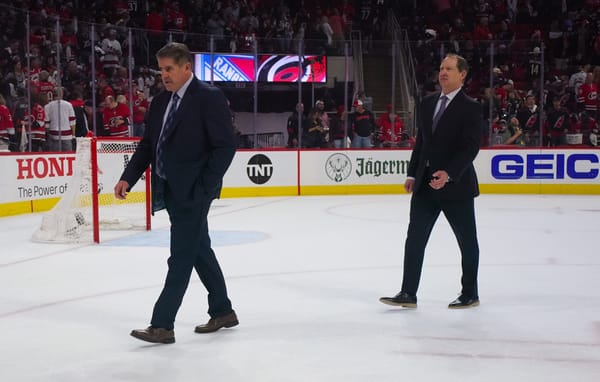Holding (Jesper) Fast
And projecting the 2020-21 New York Rangers
The 2019-20 NHL trade deadline has come and gone and veteran forward Jesper Fast, a pending unrestricted free agent, is still a New York Ranger.
By now, you have likely read and heard plenty of takes about why the Rangers didn’t move Fast. Chances are, general manager Jeff Gorton didn’t get an attractive offer and there are reasons to keep him around. He’s a coach’s dream, having won the Players’ Player award for four consecutive seasons — one of just three players to achieve that feat (the others being some guys named Jean Ratelle and Brian Leetch).
A lot of depth forwards moved on deadline day, but few of them brought back a significant return. The Edmonton Oilers coughed up a 5th round pick (2021 Draft) for Tyler Ennis, the Buffalo Sabres baffled us all when they gave up a conditional 5th round pick (2021 Draft) for Wayne Simmonds, the Philadelphia Flyers turned a 5th round pick (2021 Draft) into Nate Thompson, the Vegas Golden Knights snatched Nick Cousins from the Habs for a 4th round pick (2021 Draft), and the Colorado Avalanche acquired former Ranger Vladislav Namestnikov for a 4th round pick (2021 Draft). Noticing a trend?
There is a strong case to be made that Fast is far more valuable than any of those players, but that case is less likely to be made by those who don’t follow the Rangers closely. As solid as Fast is as a middle-six winger, most consider him to be Mr. Intangibles. Over the past three seasons, he’s averaged 0.24 P/GP — which is on par with Simmonds, Richard Panik, David Backes, and Devin Shore in the same time frame. But points aren’t everything and Fast has never been expected to be among the Rangers most productive wingers.
If you had a castle tower laboratory filled with wheelbarrows overflowing with body parts complete with a retractable ceiling that gave you access to the raw, chaotic power of lightning to fuel your unethical human experiments, you’d still have a hard time creating a better “team guy” than Fast. Over the years, he’s proven he can move up and down the lineup in addition to being a quality penalty killer and someone with a work ethic than only be described as inspirational and infectious. So, he’s a pretty great leader to keep on the roster of the youngest team in the NHL.
The rub, however, is that Fast is definitely a luxury — and he might become one that the Rangers can’t quite afford depending on how some other contract negotiations go.
The Rangers are entering the 2020-21 season with a projected $14,391,867 in cap space (thanks, CapFriendly.com) — and $7,494,444 in dead cap space (thanks, Kevin Shattenkirk buyout) — assuming an $81.5 million salary cap, but the cap is expected to increase to at least $82.5 million. So, let’s go ahead and say the Rangers will have about $15.4 million in cap space to play with. However, the roster we’re extrapolating only counts the players the Rangers have under contract now (including Libor Hajek or Nils Lundkvist as the assumed 6/7 defenseman), which accounts for 10 forwards (including Vitali Kravtsov and Tim Gettinger), six defensemen, and two goaltenders. So, let’s try and get closer to a more accurate figure.
- Pending RFAs on the roster: Tony DeAngelo, Ryan Strome, Brendan Lemieux, Alexandar Georgiev, Phil Di Giuseppe
- Pending UFAs on the roster: Jesper Fast, Greg McKegg/
Let’s assume the Rangers let McKegg leave the team to visit Dr. Nick and bring Di Giuseppe with him (either that, or he’s back in Hartford). Let’s also assume Georgiev is gone in a trade at the 2020 NHL Draft, that Lemieux comes in at a two-year deal with a $1.4 million AAV, and that Strome and DeAngelo carry a combined cap hit of at least $9.5 million. Obviously, these are just ballpark figures, but we are reading the tea leaves here so that is what we’re working with.
With the aforementioned projections, the Rangers will have 12 forwards, seven D, and two goaltenders signed with about $2 million in cap space to work with (assuming at least an $82.5 million cap) to keep Fast. Keep in mind there are a multitude of options when it comes to AHL forwards, and cheap July UFAs that could be signed, so this is a ballpark figure. Of course, this projected roster was put together with some penny-pinching in mind (Gettinger and Hajek/Lundkvist), but that number still feels pretty reasonable. If we want a bigger sandbox to play in, let’s go ahead and call it between $2-3 million with the team carrying one extra forward and one extra defender (and no third goalie).
Here’s the thing: Fast will be coming off of a three-year, $5.5 million contract with a $1.85 million AAV and he’s 28. His next contract could, and likely should, be his biggest NHL payday, especially if he’s extended by the Rangers and paid in part for the letter he wears over his breast. So, things could definitely get tight here and an extension of almost any kind for Fast could/would hamstring the Blueshirts, preventing them from making any other moves on or after July 1. But, who says they need to?
“He plays hard, and he’s got enough skill to complement people that do have skill,” head coach David Quinn told The New York Post before the deadline. “There is such an honesty to his game and it’s certainly infectious throughout our lineup. He’s an important piece of the puzzle here.”
The Rangers don’t need to make any (other) unrestricted free agent signings in July that will directly impact the NHL roster next season. After all, this team is young and developing and we should expect it to have an abundance of players who have never pushed a VHS tape into a VCR and many of those players have entry-level contracts. The Rangers have a real chance of shocking the world and getting into the 2020 Playoffs, but that doesn’t mean they need to make splashy, aggressive moves that would spray lighter fluid on the glowing embers of this year’s success.
The best thing that Gorton and company can do is to stay the course and to make the moves that need to be made — namely, solving the three-goalie carousel and deciding what to do with Strome and DeAngelo. Fortunately for the locker room, there just might be a way to stay the course while keeping Fast in the picture, but it won’t exactly be easy. Here’s hoping he loves being a Ranger just as much as the Rangers love him.
Data courtesy of naturalstattrick.com and salary cap information courtesy of CapFriendly.com.




